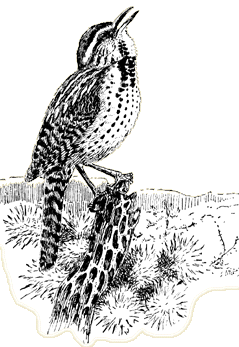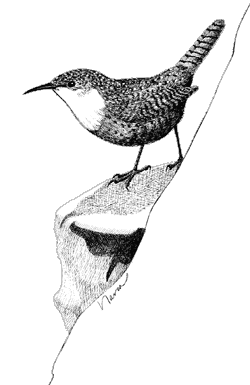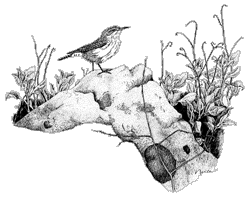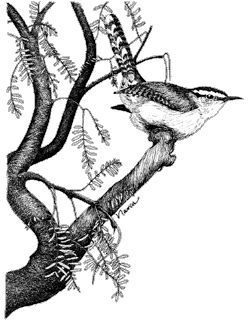Wrens
Active and inquisitive little brown birds, wrens spend their days snooping about, peering into shadows, prying with their thin bills, seeking the insects on which they feed. Often hard to see, they are easy to hear. Male wrens are inveterate singers. They are also industrious nest-builders: in some wren species, the male may build several “dummy nests” before the female chooses one, adds a soft lining to it, and lays her eggs there.
 |
Typical of the wren family is Bewick’s Wren, which hops about in the dense brush along desert washes. Usually it stays fairly low, but a male will flit to the top of an exposed stub to sing his musical trills. In more barren rocky zones, the Canyon Wren and Rock Wren manage to thrive in places where there is not enough plant life to create habitat for most birds. They play hide-and-seek among the boulders, bouncing from one rock to the next, probing into deep crevices for spiders and insects lurking there. Though the Rock Wren sings rather like a weak and uninspired mockingbird, the Canyon Wren produces a rippling, descending cascade of loud clear whistles, fitting music for the most majestic canyons of the west.
While most wrens are small, plain, secretive, musical, and solitary, the best-known wren in the Sonoran Desert breaks all those rules. Pairs or family groups of Cactus Wrens, strikingly spotted and striped, go clambering and scrambling about in the open, calling in rough scratchy voices from high perches, boldly peering in the windows of houses on the desert’s edge. Its brash behavior earns the Cactus Wren the admiration of its human neighbors and it has been selected as Arizona’s official State Bird.
—Kenn KaufmanWrens
Sonoran Desert species:
Cactus Wren (Campylorhynchus brunneicapillus)
Canyon Wren (Catherpes mexicanus)
Rock Wren (Salpinctes obsoletus)
Bewick’s Wren (Thryomanes bewickii)
Order: Passeriformes
Family: Troglodytidae (Wrens)
Other common names: Dotted Wren, White-throated Wren (Canyon Wren)
Spanish Names: matraca, saltapared (wren); matraca grande (Cactus Wren)
Distinguishing features
Cactus Wren: Large with heavily spotted underparts; spots forming a dark cluster on the upper breast in the adult. Canyon Wren: White throat and breast, overall red-brown in color. Rock Wren: Finely mottled gray-brown upper parts, finely streaked whitish breast, white streak over eyes. Bewick’s Wren: Pale gray below, dull brown above, bold white eyebrow; tail relatively long, brown with white corners.
Habitat
 |
The Cactus Wren is found in deserts and arid foothills in association with cactus, yucca, mesquite, and arid brush. The Canyon Wrens inhabits canyons, cliffs, boulder fields and other rocky areas including man-made structures; may move to streamside habitats in winter. The Rock Wren is found in arid rocky slopes and canyons. The Bewick’s Wren inhabits mesquite bosques, heavy brush along desert washes, and open woods.
Feeding
• Diet: The Cactus Wrens eats insects, other arthropods, vegetable matter such as fruit pulp, and seeds. The three other species eat mainly insects and spiders.
• Behavior: The Cactus Wren forages on the ground and in low trees, probing crevices and ground litter and often foraging in pairs or family groups. The Canyon Wren forages by hopping actively in and out of cracks, crannies and dense undergrowth in canyons. The Rock Wren forages on the ground where it uses its bill to probe for prey; it sometimes forages within brushy vegetation or low in trees. The Bewick’s Wren actively forages by clambering about on limbs of trees,probing into bark crevices; it sometimes feeds on the ground.
 |
Life History
The Cactus Wren nests from mid-March to early September. The nest is roughly the size and shape of a football, with an end opening. It is built with grasses, primarily in cholla, but also in palo verdes, acacias, and saguaros. Both parent birds construct the first breeding nest, where the female lays 3 to 5 whitish, small, brown-dotted eggs. The altricial young leave the nest at about 21 days. The male bird constructs a new nest while the female is incubating the eggs. This nest is occupied by the female as a roosting nest. The parents may raise several broods a season and these secondary nests may be used as brood nests for later clutches. Roosting nests are very important for the security of Cactus Wrens. The male cares for the young between nest-building chores while the female incubates the next clutch of eggs.
The elusive but musical Canyon Wren makes its small nest of twigs, grasses, and leaves in rocky crevices, cave ledges, rock piles, and other protected sites. White, red-brown dotted eggs (4 to 6) are incubated by the female and take 12 to 18 days to hatch. Both parents feed the nestlings. The young are ready to leave the nest in 15 days although they sometimes stay with the parents for several weeks longer.
The Rock Wren nest may be found in cracks and crevices among boulders, gopher burrows, cracks or openings in stone or adobe buildings, steep banks of washes, and other sheltered sites. The nest consists of grasses, weeds, twigs and bark lined with finer material such as feathers and hair. Brown-speckled eggs (4 to 8) are incubated by the female. The Rock Wren frequently creates a path of small rocks that lead to its nest; the purpose of this behavior is not understood.
 |
Rock Wrens are strongly migratory, spending the winter in rocky lower elevations and the summer in elevations reaching 8,000 to 10,000 feet in the northern part of their range. However, the species can be found in the Sonoran Desert region during all seasons.
The Bewick’s Wren nest is built inside almost any kind of cavity, including old woodpecker holes, natural tree hollows, or crevices in debris or buildings. Males may build several “dummy” nests, with a bulky foundation of twigs; the female chooses one and adds lining of softer material. White, brown-blotched eggs (5 to 7) are incubated by the female for about 14 days. The young leave the nest after about two weeks.
Unfriendly Embrace
As I walked to my office on a warm February afternoon I heard the familiar Chuk! Chuk! Chuk! Chuk! of a scolding Cactus Wren. I then saw the bird pursue another Cactus Wren; the second wren lacked tail feathers. The bickering and chasing continued at a frantic pace and the birds soon darted around a building. I quickly moved into a more favorable viewing position only to see the two adversaries disappear into a dense clump of jojoba. My interest piqued, I patiently waited nearby. They eventually reappeared and began a determined wrestling match less than 20 feet from me, apparently oblivious to my presence. This heated confrontation went on for some minutes until they both lay motionless, feet and wings entwined. They remained that way for over five minutes; the only indication that they were even alive was the faint movement of their tiny breasts. Finally they broke their unfriendly embrace and the tail-less bird flew to the east, its adversary in close pursuit.
This intense squabble could be explained a couple of different ways. The obvious explanation is that this was a territorial dispute between rival adult Wrens. Another possible explanation is that a parent was chasing off a youngster who was sticking around just a bit too long. With a new nesting season only a month away this second explanation seemed quite plausible.
And the missing tail feathers? They were most likely plucked out in the heat of battle—not an unprecedented occurrence. In time they will grow back.
— Steve Phillips